What Is The Subject Of This 1872 Painting
"Put Impression" is what Claude Monet said when they needed a title for the catalog for the first Impressionist exhibition in the 1800s. He used this title for his oil painting Impression, Sunrise (1872). In this commodity, we will discuss this famous Monet sunrise painting and how information technology became one of the well-nigh important defining artworks of Impressionism.
Table of Contents
- i Artist Abstract: Who Was Claude Monet?
- 2 Impression, Sunrise (1872) By Claude Monet in Context
- ii.1 Contextual Analysis: A Brief Socio-Historical Overview
- 3 Formal Analysis: A Brief Compositional Overview
- three.1 Subject Matter
- 3.2 Colour and Lite
- 3.iii Brushstrokes and Texture
- 3.4
- 3.five Perspective and Scale
- four Critical Impressions
- five Impressing a Name
- half-dozen Leaving a Lasting Impression
- 7 Frequently Asked Questions
- seven.1 Who Painted Impression, Sunrise (1872)?
- seven.2 Why Is Impression, Sunrise (1872) an Important Impressionism Painting?
- seven.3 What Place Did Monet Paint In Impression, Sunrise (1872)?
- seven.4 What Is the Worth of Monet's Impression, Sunrise (1872) Painting?
- seven.five Where Is Monet's Impression, Sunrise (1872) Now?
Artist Abstract: Who Was Claude Monet?
Oscar-Claude Monet was born on November 14, 1840, and was reported to have died in 1926, December 5 due to lung cancer. He was from Paris, and his parents were Claude Adolphe Monet and Louise Justine Aubrée Monet. He grew upwards interested in art and studied at the Le Havre secondary schoolhouse during 1851 and eventually studied at the Académie Suisse in Paris during 1858 and 1860. He also served in the armed services and traveled to Algeria during 1861 and 1862, which influenced his perceptions of art.
Monet met and studied with various prominent artists and was known as i of the founders of the art movement Impressionism.
 Portrait of Claude Monet, past the photographer Nadar in 1899;Nadar, Public domain, via Wikimedia Eatables
Portrait of Claude Monet, past the photographer Nadar in 1899;Nadar, Public domain, via Wikimedia Eatables
Impression, Sunrise (1872) By Claude Monet in Context
Impression, Sunrise (1872), known in French every bit Impression, Soleil Levant, by Claude Monet is an oil painting depicting the Le Havre harbor and the sun rising in the distance. This painting evoked various responses and critiques when it was exhibited, condign 1 of the most of import paintings of Impressionism.
In the article below, we will explore an Impression, Sunrise analysis, starting with a brief contextual analysis around the painting'due south exhibition and the development of the name "Impression". Additionally, we will also provide a formal analysis, looking at the subject matter in more detail and the unique style Monet painted in.
| Creative person | Claude Monet |
| Appointment Painted | 1872 |
| Medium | Oil on sheet |
| Genre | Landscape painting |
| Period / Movement | Impressionism |
| Dimensions | 48 10 63 centimeters |
| Serial / Versions | Part of a serial of paintings of Le Havre |
| Where Is Information technology Housed? | Musée Marmottan Monet, Paris |
| What Information technology Is Worth | Estimated worth is around $250 – $350 1000000 |
Contextual Assay: A Brief Socio-Historical Overview
The famous Monet sunrise painting anchored the name of the Impressionist art move during the 19th century, admitting derived from somewhat facetious critique. Monet painted it equally part of a serial of other landscapes or waterscapes that depicted the harbor in the metropolis called Le Havre in Normandy, France.
Titled Impression, Sunrise, Monet exhibited it with various other artists in what was known as the first Impressionist exhibition in Paris during April 1874; the location of the exhibition was reported to be the photographer Gaspard-Félix Tournachon, otherwise Nadar's, studio.
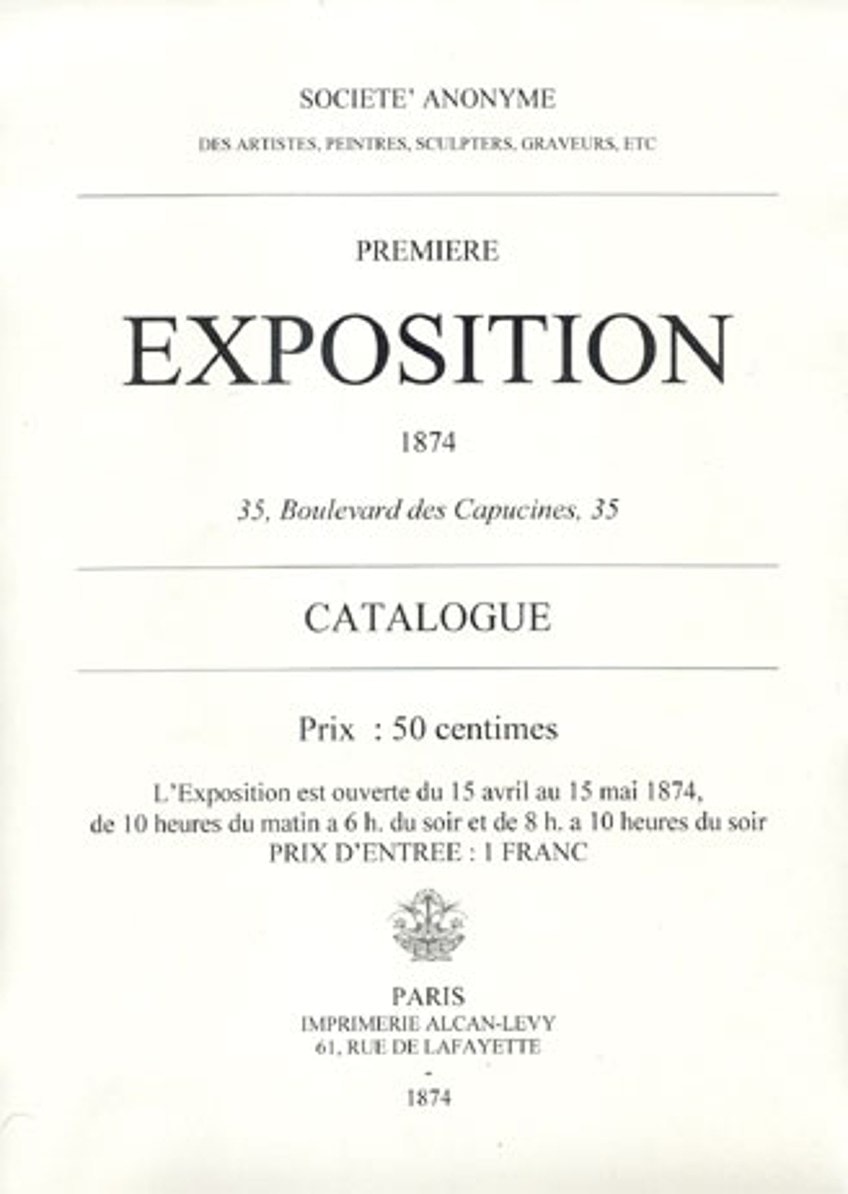 Cover of the catalog of the first Impressionist exhibition in 1874;unknown / desconocido / inconnu, Public domain, via Wikimedia Commons
Cover of the catalog of the first Impressionist exhibition in 1874;unknown / desconocido / inconnu, Public domain, via Wikimedia Commons
Some of the artists included prominent names like Edgar Degas, Alfred Sisley, Camille Pissarro, Piere-Auguste Renoir, and many others. These artists were also part of the collective group, the Société Anonyme Coopérative des Artistes Peintres, Sculpteurs, Graveurs, meaning "Cooperative and Anonymous Association of Painters, Sculptors, and Engravers". This group was created with the idea for artists to become contained of the so-ascendant exhibitory system from the Salon, which had strict rules and prerequisites for how paintings should be.
It followed criteria based on bookish art rules, which, for some artists, did not fit with their progressive painting styles in the prevalent mod era, as we shall run into from Claude Monet's artwork.
"The Exhibition of the Impressionists"
When the exhibition was held in 1874 Monet'southward sunrise painting was heavily critiqued by Louis Leroy, a author, artist, and critic at the fourth dimension, of which, he was a journalist for the La Charivari newspaper. His review of the first Impressionist exhibition was titled "The Exhibition of the Impressionists", published Apr 25, 1874.
In this review Leroy wrote well-nigh Monet'southward Impression, Sunrise: "Impression – I was certain of it. I was simply telling myself that, since I was impressed, at that place had to exist some impression in it…and what freedom, what ease of workmanship! Wallpaper in its embryonic state is more than finished than that seascape".
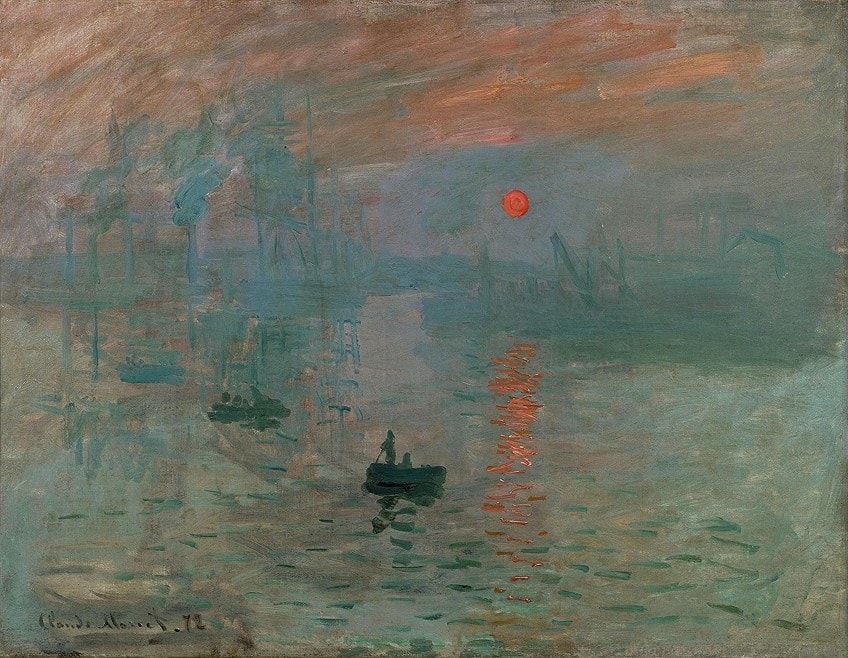 Impression, Sunrise (Impression, Soleil Levant) (1872) past Claude Monet;Claude Monet, Public domain, via Wikimedia Commons
Impression, Sunrise (Impression, Soleil Levant) (1872) past Claude Monet;Claude Monet, Public domain, via Wikimedia Commons
As snide and tongue-in-cheek as the review was, not only about the Monet sunrise painting but many others, it also remained in the minds of the many and it became the term that would define and name the art movement for all history and time to come. Maybe Leroy indirectly did all the Impressionists a favor? Fortunately, the negative associations tied to the term did non remain and the movement grew into its own.
Impressionism Before Impressionism As We Know Information technology
Information technology is of import to note that before the Impressionist motility became what nosotros know it every bit today, its legacy comes from the Barbizon School, which was equanimous of important artists like Théodore Rousseau, Jean-François Millet, Édouard Manet, and others.
The dominant characteristic of this school was to redefine the status of landscape paintings from its depression-tiered position among the ranks of the hierarchical system of paintings outlined by the Academy, with History painting existence at the top of the hierarchy. Artists enjoyed painting in the en plein air style, which simply means "in the open air" in French; artists painted outdoors. Their style was also characterized every bit being freer in the usage and application of brushstrokes and pigment.
This style influenced the Impressionists artists, notably Monet, who visited the location of the schoolhouse near the Fontainebleau Forest and learned the painting styles from various Barbizon School artists.
Formal Assay: A Brief Compositional Overview
Below, nosotros will have a closer wait at Claude Monet's Impression, Sunrise, a composition that gives ascension to inklings of forms in swathes of colors and textures. At first, we might not sympathise what it represents. In fact, it relays an impression of a scene, simply the subject volition unfold the more involved we get in it.
Subject Matter
Equally we mentioned above Claude Monet painted a scene of Le Havre harbor, which was among other renditions of the port based on his experimentation with colors and calorie-free. He is widely quoted as having said about these series of paintings depicting the harbor in dissimilar times of the day, namely:
"During dawn, solar day, sunset, and dark and from varying viewpoints, some from the water itself and others from a hotel room looking downwardly over the port".
In Impression, Sunrise Monet reportedly depicted the harbor from his room viewpoint at sunrise. Nigh the heart left foreground, there are three rowboats. The i closest to us, the viewers, is darker and appears silhouetted. Behind the above-mentioned rowboat is another in a lighter shade of gray to propose that information technology is moving further into the hazy distance of the misty background. This is followed by a third rowboat sailing into seeming obscurity, well-nigh becoming one of the brushstrokes of paint that are wholly recognizable and questionably function of the discipline matter itself.
 Details of Claude Monet's Impression Sunrise (1872);Claude Monet, Public domain, via Wikimedia Commons
Details of Claude Monet's Impression Sunrise (1872);Claude Monet, Public domain, via Wikimedia Commons
In forepart of us is a vast composition of water, and the groundwork depicts scraggy forms suggestive of dissimilar kinds of ships like steamships, clipper ships, and pack boats. We will detect thick billows of fume ascension into the sky from the ships from the left background, moving towards the right-hand side of the composition.
The ships in the background to the right are more unrecognizable.
Between the ships to the left and correct-paw side, we will notice a gap where the water leads into the far afar background of what appears to be either the balance of the landscape or perhaps the rest of the city. Yet, this water leads to the orange-reddish ball that is the rising sun, which is positioned slightly towards the correct and nearly in the key groundwork.
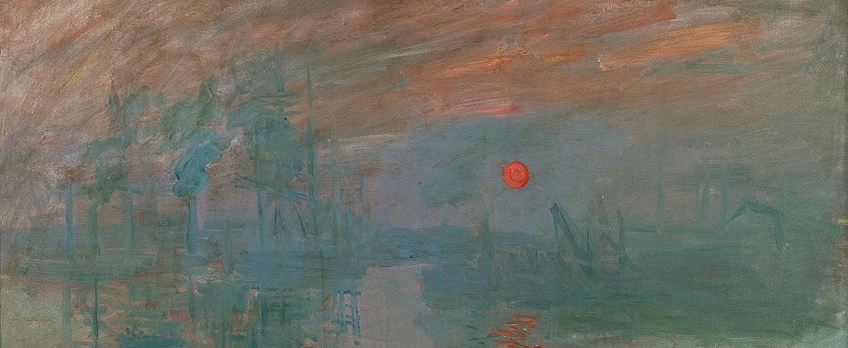 Shut-up of Impression Sunrise (1872) past Claude Monet;Claude Monet, Public domain, via Wikimedia Commons
Shut-up of Impression Sunrise (1872) past Claude Monet;Claude Monet, Public domain, via Wikimedia Commons
We see the expanse of the sky around the sun and to a higher place the harbor and water. It is as if Monet creates a meeting indicate between the h2o and the sky with the harbor and its ships in the heart ground. The light of the morning time sun dapples the h2o in the foreground.
An interesting point virtually this composition is that there were apparently houses to the left. Yet, Monet did not describe these due to the focus he wanted to place on the emerging industry, which he depicted through the various ships, chimneys, cranes, and smoke rising into the air.
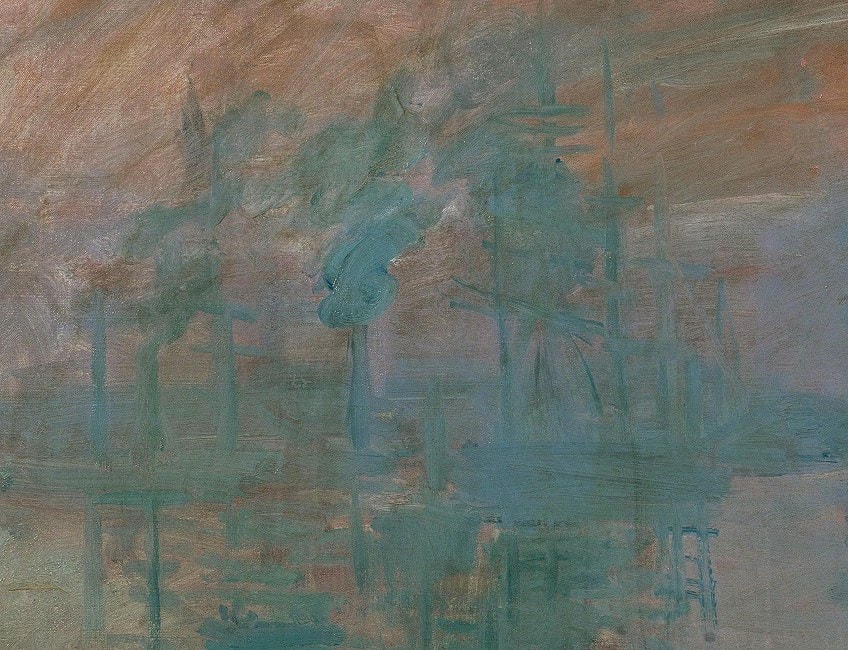 The (left) groundwork of Impression, Sunrise (1872) by Claude Monet; Claude Monet, Public domain, via Wikimedia Commons
The (left) groundwork of Impression, Sunrise (1872) by Claude Monet; Claude Monet, Public domain, via Wikimedia Commons
The theoretical work of Paul Tucker, an fine art historian, is often referred to regarding this painting. He proposed that Monet's painting was a reference to the rebuilding of French republic later on the war with Prussia in 1870. Tucker is quoted as having written how the painting has characteristics of being fine art that could "lead".
He farther explained, "While it is a poem of calorie-free and atmosphere, the painting tin also be seen as an ode to the power and beauty of a revitalized French republic". The port of Le Havre was undoubtedly a beacon of this revitalization, and some sources also propose that the sunrise symbolizes this besides.
Color and Calorie-free
Monet utilized color and light in Impression, Sunrise to convey the early hours of the morning. The principal colors used comprise cooler blue-grayish tones, which are contrasted with the orange from the rising lord's day. We will notice this orange color in the heaven, giving information technology more warmth, as well as the sunday'south reflection of the water.
We see this scene equally a misty morning; the colors boss what is visible to the states and the subject area and formal elements get interchanged. The orange from the sun becomes a dominating factor too and information technology catches our eyes.
Monet utilized a shut selection of most complementary color schemes here.
 Color and light in Monet'due south Impression, Sunrise (1872); Claude Monet, Public domain, via Wikimedia Commons
Color and light in Monet'due south Impression, Sunrise (1872); Claude Monet, Public domain, via Wikimedia Commons
Scholars similar Dr. Margaret Livingstone, a Neurobiologist, have studied Impression, Sunrise in more depth. In that location is a lot to exist said about the idea of luminance and how it is conveyed in this painting. In fact, Dr. Livingstone has explained that when viewed every bit a black and white re-create, the lord's day "disappears [most] entirely".
This points to how Monet managed to convey low-cal as nosotros perceive information technology with color.
Furthermore, Dr. Livingstone has researched the unlike areas of how our brains process what she describes as two different areas in the human visual system, namely, color and luminance. Her publication Vision and Art: The Biology of Seeing (2002) provides extensive research about the above-mentioned and how this affects the way we see art; in this case, Monet's Impression, Sunrise painting.
Brushstrokes and Texture
If we wait at Monet's use of brushstrokes it conveys a complete deviation from what was expected from painting. Instead of perfectly executed brushstrokes and well-contoured outlines, we run into the actual markings from the brushwork. Some might think information technology appears rudimentary in its execution; notwithstanding, this was also a typical feature of Impressionism and an case of how artists employed the en plein air manner, often painting in a single sitting.
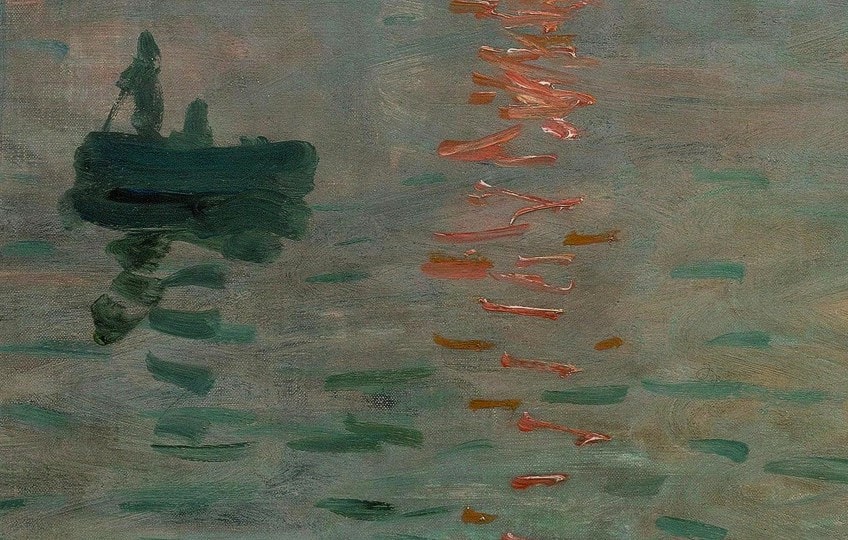 Brushwork in Impression, Sunrise (1872) by Claude Monet;Claude Monet, Public domain, via Wikimedia Commons
Brushwork in Impression, Sunrise (1872) by Claude Monet;Claude Monet, Public domain, via Wikimedia Commons
Yet, the way Monet painted in a seemingly rushed manner and brushstrokes could too advise his focus on wanting to create a scene that simply represented a quick "impression" of the harbor, then to say. Some sources as well indicate to what scholars similar Paul Smith have suggested about the painting, that it may have been Monet'southward way of expressing his "individuality" and his search for "spontaneous expression".
Perspective and Scale
If we wait at the perspective, Monet presents a scene from what appears to be a slightly elevated vantage point. We are seemingly looking downwards at the boats and the area of h2o, and our viewpoint seems to exist more at eye level with the ascension sun.
Monet created the representation of a large body of water that appears to be on all sides of the composition and does not end anywhere in our line of sight; the water runs to the left, correct, and into the distance. The background is set with the hazy boats lined up in the harbor and the three boats in the foreground diminish in size as they move further towards the background.
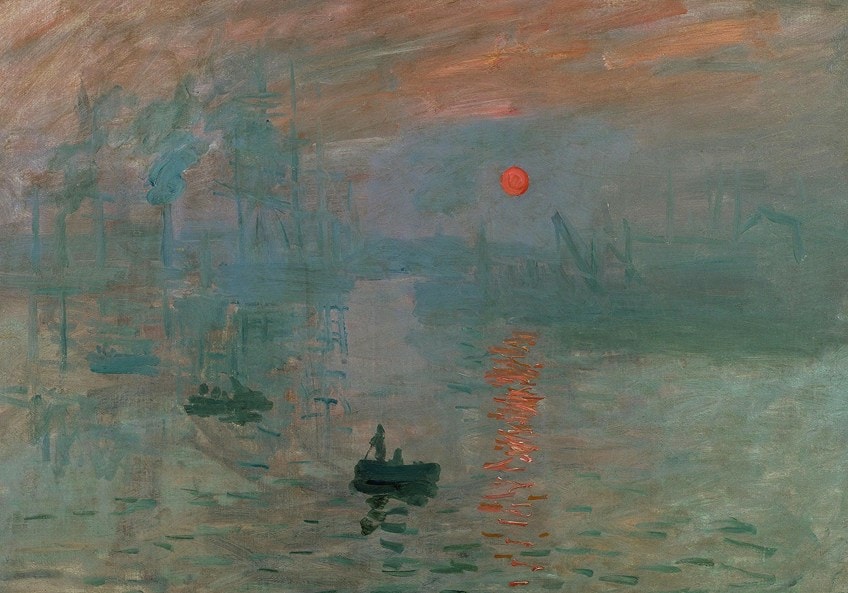 A close-up of Monet's Impression, Sunrise (1872); Claude Monet, Public domain, via Wikimedia Commons
A close-up of Monet's Impression, Sunrise (1872); Claude Monet, Public domain, via Wikimedia Commons
Disquisitional Impressions
Monet's Impression, Sunrise created quite an impression when it was offset exhibited, and information technology has often been described as becoming ane of Monet's more popular pieces because of its infamy, and then to say. This was a unlike type of painting compared to others of the time, although it was not only Monet's painting that was different. Back then, it was xixth century France, a time when art was conservative and expression followed rules and restraints.
However, a few artists started challenging the rules with more than progressive and expressive ideas, and Monet was one of them.
With that, it is worthwhile to know how others responded equally we have already mentioned the impression Louis Leroy communicated in his review, mentioned above. Other critics and journalists similar Théodore Duret explained Monet'southward approach to painting and that the creative person diverted from painting "the immobile and permanent aspect of a landscape" and instead painted the "fleeting appearances which the accidents of temper present to him", furthermore, Duret explained that Monet presented a "hit sensation of the observed scene".
 Claude Monet'southward Impression, Sunrise (1872) framed on the wall of an Impressionist exhibition; Ministério da Cultura, CC BY 2.0, via Wikimedia Eatables
Claude Monet'southward Impression, Sunrise (1872) framed on the wall of an Impressionist exhibition; Ministério da Cultura, CC BY 2.0, via Wikimedia Eatables
The art critic and journalist Jules-Antoine Castagnary, who wrote a review in the newspaper Le Siècle in Apr 1874, stated that the grouping of Impressionists were a "collective strength within our disintegrating age" and that they did non "aim for perfection, but to be satisfied with a certain general aspect".
He also wrote that the term "Impressionists" was the best word to describe them, and further explained how the grouping of artists focused on producing the "sensation" inherent in the landscape and not and then much the actual landscape itself. He continued to say that the word "Impression" has become part of the language used by the artists, and that "the Sunrise by Monet is called non landscape, only impression. Thus they take leave of reality and enter the realms of idealism".
At that place were other negative reviews not only of Monet'southward painting but also of the Impressionist's exhibition. However, these were catalysts for the evolution of the Impressionism art movement and the artists associated with it who started using the term to describe their fine art mode.
What was once derogatory and misunderstood became something positive and expressive.
Impressing a Name
Monet is also often quoted as having said in an interview that a landscape is "only an impression" and something that is "instantaneous", he continued to explain that this is why they are called Impressionists and that information technology was considering of him.
When he further explained how the name bore then much weight he said that a proper noun was needed for the catalog and he told them to "Put down 'Impression'".
Impression, Sunrise has long been regarded as the painting that marked the proper noun for the Impressionists, who all painted their ain versions of impressions from outdoor scenes, conveyed through their utilization of color and light to describe sensations and temper.
Other examples from Monet'due south oeuvre include his Haystacks series from 1890 to 1891, his Water Lilies series from around 1896 to 1920, as well equally his Rouen Cathedral series from 1892 to 1894. From these series, we will also see the artist's expressive exploration of not only luminance merely also how colors and course almost become the subject field affair, alongside the effects and changes of the natural environments.
 Haystacks (1885) by Claude Monet; Claude Monet, Public domain, via Wikimedia Eatables
Haystacks (1885) by Claude Monet; Claude Monet, Public domain, via Wikimedia Eatables
Leaving a Lasting Impression
Claude Monet became one of the all-time-known artists from the 19th century, not only considering of his role in laying the foundations for the Impressionism fine art motion, but also for his unique artistic style and approach to his environment.
During his last years, he lived in Giverny, French republic, which was his home for numerous years and the source of his famous Water Lilies series mentioned above. Furthermore, it was also the source of great creativity because the artists congenital his famous Japanese gardens there too. This menstruum also marked increasing prosperity for the artist.
 Waterlilies (c. 1906) by Claude Monet;Claude Monet, Public domain, via Wikimedia Eatables
Waterlilies (c. 1906) by Claude Monet;Claude Monet, Public domain, via Wikimedia Eatables
Monet left a lasting impression for other fine art movements to come, for example, the notable Abstract Expressionism and its pioneers like Jackson Pollock and Mark Rothko drew inspiration from what has been described as Monet'southward "semi-abstruse" compositions. Pop Fine art and Minimalists besides drew inspiration from Monet's oeuvre, especially regarding paintings and pieces made in a ready or serial.
In Monet'southward paintings, we will undoubtedly find a beguiling world made upwardly of colors and brushstrokes that define the perception of low-cal and form, something that Monet was indeed especially fond of exploring as we have explored in the "Impression, Sunrise" analysis above. Monet art lovers volition certainly notice "Impression, Sunrise" an enticing portrayal and example of Impressionism, which upended the notions of how reality was depicted. "Impression, Sunrise" is housed at the Musée Marmottan Monet in Paris. This museum also houses other of import artworks by Monet, including paintings from his famous series mentioned above.
Take a look at ourImpression, Sunrisewebstory here!
Frequently Asked Questions
Who Painted Impression, Sunrise (1872)?
Oscar-Claude Monet painted Impression, Sunrise in 1872 as part of a series of paintings. He was regarded every bit one of the fathers of Impressionism.
Why Is Impression, Sunrise (1872) an Important Impressionism Painting?
Claude Monet's Impression, Sunrise is an important painting because information technology gave the art movement Impressionism its proper name. Subsequently the painting'southward exhibition when Monet used the term "impression" in the title and the fine art critic Louis Leroy used the term pejoratively in a critical review. This set the foundations for the group of artists who referred to themselves as the Impressionists after.
What Identify Did Monet Pigment In Impression, Sunrise (1872)?
Claude Monet painted Impression, Sunrise from his window overlooking the Le Havre harbor. Le Havre is in Normandy, France, a place where Monet likewise lived when he was a younger boy; his family unit moved there in 1845.
What Is the Worth of Monet's Impression, Sunrise (1872) Painting?
Monet's Impression, Sunrise painting is estimated to be worth betwixt $250 to $350 million, withal, many of Monet's paintings could besides be argued to be priceless in their value.
Where Is Monet's Impression, Sunrise (1872) Now?
Impression, Sunrise is housed in the Musée Marmottan Monet, which is in Paris, France. Many of Claude Monet's other famous artworks are also housed here, including paintings from his famous Water Lilies series from 1896 to 1920, comprising over 200 compositions, and paintings from his Rouen Cathedral series (c. 1892 to 1894).
Source: https://artincontext.org/impression-sunrise-claude-monet/
Posted by: jacobsyoublive.blogspot.com





0 Response to "What Is The Subject Of This 1872 Painting"
Post a Comment